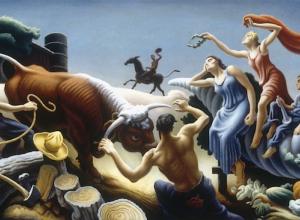The organization of the exhibition thematically corresponds to five chapters in Bachelard’s book, with major recent acquisitions highlighted in each section:
“Intimate Immensity” refers to the physical awareness that arises when realizing one’s small place in a vast world, exemplified by Pipilotti Rist’s Massachusetts Chandelier, made of many pairs of intimate clothing, and Janine Antoni’s Grope textile sculpture of men’s pants pockets.
“Drawers, Chests, and Wardrobes” features household objects that conceal private desires—playful sculptures by Olivia Erlanger, Sarah Lucas, and Robert Pruitt—or haunting memories—commemorative works by EJ Hill, Doris Salcedo, and Danh Vo.
“Dialectics of Inside and Outside” explores physical, psychological, and social boundaries. Alex Da Corte’s neon house-frame installation, Rubber Pencil Devil, lures visitors in to watch a sequence of absurdist videos. Three-dimensional works by Margaret Lee, Betty Woodman, and others hover between mediums.
“Shells” interprets buildings as expressions of their inhabitants’ personalities. Do Ho Suh recreates an entryway to his childhood home in delicate fabric, in a work titled Hub, 260-10 Sungbook-dong, Sungbook-ku, Seoul, Korea. This section includes a broad selection of photographs that depict living spaces by 15 artists including Judy Fiskin, Misty Keasler, and Annette Lawrence.
“Nests” focuses on rooms as containers for relationships. In Chapel, Francisco Moreno borrows a historical structure and personalizes the interior with an epic collage of cultural references. Paintings, photographs, and works on paper by Jacob Lawrence, Clementine Hunter, Bill Owens, and others show gatherings of friends and families.



























